By Matt Bailey
Bachelor of Science and Bachelor of Commerce
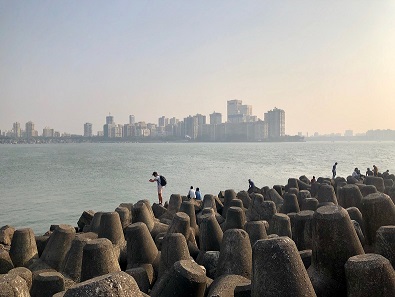
Among the chaos of Mumbai, spatial constraints have led to wildly creative ways of people using space. To me, nothing seems fixed, the wonderfully disorderly city feels like an evolving entity. The dynamic megacity regularly endures monsoonal flooding. Vast informal squatter settlements are swamped, yet defiantly recover time and time again. However, with climate change and mean sea level rise, storm surges, cyclonic and flooding events will increase in both intensity and frequency. I wonder how resilient Mumbai will be in the next few decades.
Originally a cluster of islands, a large portion of Mumbai is now situated on low-lying, flood-prone reclaimed land. Compounding influences of rising sea levels and increased rainfall will cause dramatically increased flooding, infrastructure damage, threaten water security, compromise sanitation, pose risks to health and introduce new conflicts over land. Over the course of the century, sea-level rise will place at least half of Mumbai’s population (roughly 10 million people) at clear threat.
Particularly at risk are those living in informal squatter settlements situated on mud flats and estuaries. These communities are among the most densely populated areas in the world and lack any sort of formal stormwater system. Even in the areas which have waterways, I notice they contain large amounts of plastic rubbish and debris which would no doubt cause clogging during the floods. Squatter residents will be the first people to be impacted. I’m not optimistic about how resilient these settlements will be to future changes in sea level and flooding intensity, compounding on existing coastal instability.
I have found several references to Mumbai’s flood and coastal risk management strategies, but these seem inadequate given the size of the problem. In the picture above is the tetrapod seawall we visited along the waterfront of Marine Drive in Mumbai. Prior to its urban development, the coastlines of Mumbai would have been protected from tides by mangroves. In their absence, a seawall is effective – excellent for dissipating wave energy at current sea levels – but a ‘band aid’ solution nonetheless. There is no sign Mumbai will reduce or slow further development on its unstable coastline. Planned encroachment into mudflats and mangroves compromises these natural drainages and flood controlling mechanisms.
As India’s economic powerhouse, the implications of Mumbai’s coastal exposure are significant. Vulnerability is a measure of not only exposure to the risk but the gravity of consequences for the densely populated megacity. This bustling city is ever adapting, but as of now it lacks the planning, investment and political will to safeguard its future. Mumbai, it seems, reflects Rajendra Pachauri, Chairman of the Intergovernmental Panel on Climate Change, opinion that “On a scale of 0 to 10, India scores a poor 0.5 in preparedness for the effects of climate change that could include severe water scarcity, floods, drought and mass migration”.
Author: Elizabeth Hill
An Indian field school for political economy and geography students in India
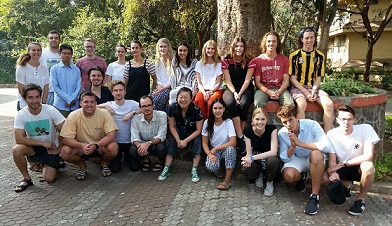
Twenty-two students majoring in political economy and geography have arrived in Mumbai for a three week intensive field school experience. The field school is run by the Departments of Political Economy and Geography in collaboration with Indian university, the Tata Institute of Social Sciences (TISS). The field school involves an intensive, integrated three-week program of classes and field visits addressing the political economy of development and environmental management in modern India. Students are engaged by Indian scholars and civil society groups working on issues of geo-political, economic and environmental importance and gain firsthand insight into the challenges facing one of the most important nations in the contemporary global economy.
The first week of the program will be run at the TISS campus in Mumbai. Students will stay on
campus at the Tata Institute of Social Sciences and participate in tailored classes and city field visits
developed by the local academic staff, in close collaboration the University of Sydney convenors.
This component of the field school will address India’s ‘national story’ of development and inspire
questions about the contested process of economic development, environmental sustainability and
social inequality.
In the second and third weeks of the program involve travel to the southern state of Kerala. We will
fly to Kozhikode, also known as Calicut, and then travel by bus to the rural district of Wyanad. Our
partners, TISS Kerala, have undertaken social audits of this district and they will join us in visits to
villages where we will learn about the contested relationships between economic development, human security and ecological sustainability in this region. We then travel back to Kozhikode to visit
local fishing communities. Researchers from TISS Kerala will brief us on work they have been doing
on the sustainability of coastal fishing communities, during field site visits. Then, we will take a train
trip from Kozhikode to the historic city of Kochi (also known as Cochin) to look at the effects of
tourism and urban development, and then head up to the famous tea plantation districts near the
town of Munnar, to examine how this industry has been affected by economic restructuring and
globalisation. The final leg of our journey then takes us to the city of Allepey to investigate the
effects of flooding, and then to Kerala’s capital, Thiruvanathapuram (also known as Trivandrum), for
seminars with policy‐makers and researchers on Kerala’s story of development and sustainability.
We will also make a field visit to the Laurie Baker Centre for Habitat Studies, where will we learn
about affordable and environmental housing. During our time in Trivandrum, we will be staying at
the Sagara Resort Hotel in Kovalam Beach, just 20km outside of the city. This hotel was designed by
architects working with the Laurie Baker Centre, and incorporates eco‐friendly design principles. Our
final destination is Kanyakumari, the southernmost tip of the peninsula, where we can dip out feet in
the water at the very extreme end of India.
The blog posts that follow will capture the student experience of contextualized learning and their reflections.
Have you seen the new iphone?
By Ira Brenner
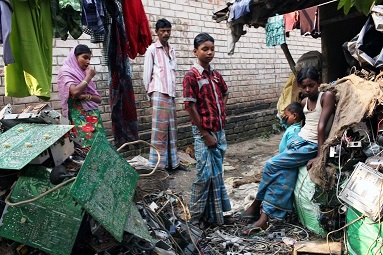
India’s mining industry is growing. New jobs, unskilled workers employed and untapped resources discovered. But it isn’t the substance of mining you would expect. I’m talking about urban mining. That is, the process of reclaiming materials from spent products, buildings and waste generated in the urban environment. It’s recycling the precious metals permeated in urban waste. Sounds appealing so far – a salvation for all that waste we guiltily expend. In fact its not just any waste, its that deleterious waste, in which we know little of its end – electronic waste.
Urban mining is a lucrative business as it is estimated 55 billion euros worth of raw materials lie in unused electronics worldwide. Up to 60 elements from the periodic table can be found in them including highly demanded minerals the world is currently running short on such as gold, copper, nickel and iron.
In 2016 the global quantity of e-waste was around 44.7 million metric tonnes (Mt) or 6.1 kg per inhabitant – equivalent to 4,500 Eiffel towers and by 2021 it is expected to grow the 55.5 Mt. It is hardly surprising considering India’s mass population and fast growing electronics industry that it has become the worlds 2nd largest consumer of phones and hence the worlds 4th largest e-waste polluter.
There are now over 1 million people in India employed in informal operations in the manual recycling process of e-waste and they are all eager for a share in the potential profit. While urban mining provides income earning opportunities for some of India’s poor, the process is highly problematic. Firsty, unscientific treatment (without any safety measures or even understanding the toxic materials) of e-waste such as burning, recycling and chemical digestion has calamitous effects on human health. Everyday workers deal with perilous toxic chemicals present in electronic products that have been found to cause serious and irreversible long term and short term damage, such as intergenerational brain damage, cancer, respiratory and skin disorders, immune system damage and muscle weakness – to only name a few. Secondly, as most of the electronic matter fails to decompose, there is significant air, water and soil pollution emitted, which in turn incurs negative health consequences to the broader community as well as the biodiversity.
It’s a grim picture of an unfortunate consequence of uneven development and absent regulation but it’s not to say that we should all give up our treasured technology because of its disastrous effects. A push has been made by way of producing electronic equipment with minimum toxicants, which some NGOs such as Toxics Link, have began activity pursuing. Since a 2003 European Union incentive to restrict the use of hazardous parts, the composition has become less deadly, albeit still harmful. More momentous is the international movement towards recycling e-waste with zero landfill under scientifically proven safe methodology. For most of the developed world, zero landfill is a reality but for India it remains a distant dream. Nonetheless, over recent years, Indian academics, scientists and NGO’s have been pressing the government to implement a zero landfill program to save lives. In response, the central waste management act has been amended and provisions such as the Extended Producer Responsibility has been mandated, yet policy is much inadequate and enforcement remains very limited.
In any case, awareness and pressuring the government for change seems to be the best viable action. Only under a proactive government that takes responsibility for the security of its people, will India be able to grow sustainability and inclusively. It’s not that poor workers wish to inhale toxic chemicals as a form of employment but rather there is no better option.
Reflections on ‘informalisation’ in the Indian economy
By Brendan Hancox
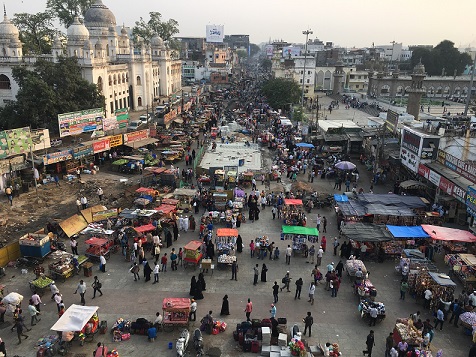
Among the many staggering facts, statistics and stories we have heard throughout our three weeks in India, one theme sticks out to me:‘Informalisation’ in the Indian economy. This continues to intrigue me with 92 per cent of the Indian workforce employed in the ‘informal’ sector. What does this mean? Well, strictly speaking, it means that the 92 per cent of Indian workers do not have a formal employment contract nor the legally enforceable benefits, securities and workplace protections that come with them. We could have learned this statistic from the confines of a lecture room back in Sydney, but one of the advantages of coming on a field school is getting a first-hand sense of how ‘informality’ manifests in the workplace as well as in the broader society.
To survive as a labourer in the Indian economy, you have to be flexible, nimble and hard-working. The streets of Mumbai or Hyderabad are buzzing with all sorts of sights and sounds, from the putt-putting of auto-rickshaws driven by self-employed auto-wallahs jostling to secure a ride, to street vendors and hawkers pushing food carts, and even hand-craftspeople, plying trades such as basket-weaving by the side of the road. From the open balcony of our seminar hall at the Tata Institute of Social Sciences in Mumbai, I see un-harnessed construction workers straddling the bamboo skeleton scaffolding of a mid-rise build site in the distance. I imagine they are seasonal migrants from the country, similar to the ones I have read about, who gather on street intersections each morning in search of casual day labour for several months of the year, driven to work informally and in unsafe conditions by a mix of desperation and opportunism. I can only wonder about other migrant labourers who I have read about but are completely hidden from view, such as the growing army of informally employed domestic workers – mostly women maids – servicing the homes of the Indian middle class.
Another thing you need to survive as a labourer in the Indian economy, so I’ve learnt, are social connections. Mediators and middlemen facilitate the movement of labour across the country, mostly from the countryside to the city. More generally, informal social linkages are essential in an economy where relations of trust, reciprocation and honour are more important for securing work than formal qualifications. My suspicion is that these social linkages help to explain the overwhelming dominance of ‘informalisation’ in the Indian labour market: promises and social sanctions act as substitutes for the legal protections associated with formal employment.
This is far from something to be optimistic about, however, if one appreciates how social and hence labour relations in India are infused by the caste system. Although it is illegal for employers to discriminate based on caste, the idea that certain jobs should be reserved for particular hereditarily defined social groups – or castes – still pervades the Indian milieu and effectively stymies social mobility. In this context, the social and informal networks that underwrite the informal economy are not some politically-neutral mechanism through which the labour market operates. On the contrary, they entrench the existing economic and social inequalities that are so palpable whenever one travels through a major Indian city. They are a mechanism through which the politics of caste are reinforced and reproduced.
So is formalism the way to go? Well, yes – all workers deserve decent working conditions, and state regulation of labour standards could be a way of enforcing anti-discrimination laws that already exist on paper. But the mind boggles at how such a dynamic, fast-paced and truly enormous labour market could be brought under the effective regulation of the state. Furthermore, understanding how entwined the labour market is with caste and informal social networks allows one to appreciate the enormity of the challenge: a fully fair and meritocratic labour market requires more than top-down policy. It requires a wholesale shift in the nature and structure of social relations – unfortunately something not likely to happen in the near future.
All good, dhal?
By Eliza Bicego
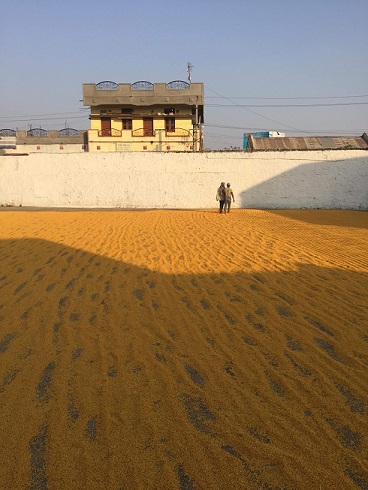
Everywhere we’ve gone in India, at every meal, there’s been dhal.
Demand for dhal in Karnataka and surrounding states is so high that in Gulbarga alone there are 325 dhal factories who all turn around approximately 100 tons of dhal a day. It was pretty fitting that we visited a factory which processes raw lentils, or dhal, into the core ingredient of the staple dish we’ve been enjoying. The factory turned a high profit and we discussed with the owner how business was usually pretty good; everyone always wants more dhal.
When we arrived at the factory we were greeted by a sea of yellow; the concrete of the large front courtyard was covered in dhal drying out and splitting in the sun. Later we saw men walking barefoot across the lentils in tandem, turning them to ensure even drying.
The workers at the factory were all migrants from Bangladesh or Nepal, or other states in India. These are season workers who often return home during the monsoon season when dahl production is halved. The workers live 20m from where they work and got the job often through family or community ties. Even though we were offered face masks to protect our lungs from the fine dust of production, none of the workers had anything more than a cloth they tied around their noses. They worked close to heavy industrial machinery in sandals and could collect 100 rupees/month for 2 months if they injured themselves while working.
The workers were mixed, men and women, and everyone worked 10 hours days. We were informed, however, that men were paid 400 rupees/day (equivalent of .80AUD/hour) and the women 300 rupees/day (.60AUD/hour). The women didn’t do the heavy work which explained the pay discrepancy but this stratification, spoken as if it were natural by the factory owner, was a clear manifestation of the deep gender divisions which run through most of Indian society.
The factory owner was an educated Indian businessman who spoke fluent English. He was from Rajasthan, although born in Karnataka where his family had been processing dhal since 1902. Heritage, culture and language are so tied to locality within India that this man had only ever been to Rajasthan twice but still identified strongly as being Rajasthani and spoke a language from his home state with his children. He had grown up on the factory floor, identifying the different grades of dhal and helping the workers to turn the lentils with his bare feet until he was old enough to take over the business.
Funny to see the lives and livelihoods and bare feet behind the food we’d been happily tucking into for the last three weeks.
Holy Cow….Dung
By Nicole Runck

While driving to a rural village in the state of Rajasthan I pulled my curtain across to take in the surroundings. The landscape was dry, scattered with plots of green. The roadside supported a number of small shops, crowded with small groups of men gathered, drinking chai. The view from the bus was a fascinating glimpse at rural life in India, but there was one scene in particular that continued to grab my attention. And that was the piles and piles of round brown discs – cow dung patties.
Their Indian name (as I later learnt) is “goitha” and they are used by millions of people across India as a source of fuel for cooking. Women in rural villages are in charge of collecting faeces from bovine species, mixing it with hay, moulding into discs and laying them out to dry. Once dry they are ready to fuel stoves and fires all year round.
Once we arrived in the rural village and spoke with the local women’s group we learned that almost every single household had an LPG connection in their home. But most still preferred to cook with wood or cow dung because it makes the food taste better. Yeah, so apparently cow dung makes food taste great, so much so that there is now an online market for dung patties from city dwellers wanting a taste and smell of their rural childhood!
At first glance the use of cow dung as a source of fuel seems greatly sustainable not to mention affordable. The problem is the negative affect of these more traditional sources of fuel on household health.
Indoor pollution is recorded to be responsible for around a million deaths every year in India. Burning solid fuels- such as cow dung creates smoke particles that are damaging to human health. And since almost all cooking happens in the house, every day millions of Indians are exposed to harmful pollutants in the quest for sustenance. In fact, up to half of premature deaths among children can be linked to the inhalation of particle matter.
The Indian government is responding to the issue undertaking a large roll out of LPG to rural households and subsidising the cost of gas. So why do so many Indian families still opt for traditional forms of fuel?
Of course the answer is not simple, and can definitely be equated to the cost associated with LPG. But as one scholar at the TISS/USyd workshop on ‘Well-being and Social Welfare in 21st Century India’ argued, education is a key factor preventing rural communities from using their LPG connections. The government is not investing in the knowledge dissemination that would inform rural communities of the health benefits of switching to other fuel sources. This highlighted the importance of government led initiatives such as LPG provisions to include educational programs to ensure proper implementation and better health outcomes.
A Walk Through History
By Janine Farah
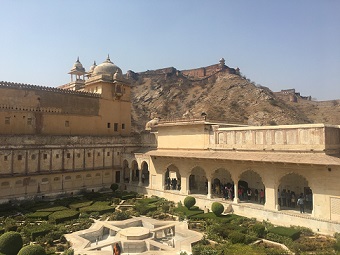
Echoes of the British Empire can be seen in many different ways within India. From television shows to restaurant chains to the education system. However, if these remnants make you think India’s culture and history have been repressed or erased, you would be mistaken.
During this field school we had the incredible opportunity to visit the Amber Fort and see firsthand the rich history and culture that India has to offer. The fort stands in grandiose style over a hilltop and is a feast for anyone who values a trip to the past. This rambling Amber Palace offers a curious blend of Muslim and Hindu architectural design. This is due to political alliances between the Rajput rulers and the Mughals, two different clans, during the medieval era. An exhibition of the yester years, this site is a testament to the ingenuity of the artisans of ancient time.
This tour taught us that Man Singh, the commander of Emperor Akbar, started the fort in 1592 and from the 16th century up to the foundation of Jaipur in 1727 the Amber Fort was used by the Rajput’s as a place of residence as well as defence purposes. The Rajput’s were Hindu rulers who had excellent knowledge of ancient building methods. They build the fort in a defensive architectural style by utilizing the natural features of the site. Not only was this fort used for defensive purposes but is also displayed the honor and wealth of the Maharajas. As we walked past the mighty walls and picturesque gardens we were transported to a time of royalty, grandeur and splendour. Marble and stone line every corner; elaborate paintings and stonemason’s work cover the walls.
Walking through this fort I began to think about the importance of conservation of such significant cultural and historical sites. A tour guide walking ahead of us said something that stood out to me. He said ‘The identity of India is linked with our past.’ Sites like the Amber Fort represent a part of Indian cultural identity that means more than a pretty place for tourists to visit. During the British rule, no major construction work was done in the Amber Fort and their colonization marked the beginning of tourism for many European travellers. The amount of tourists led to a significant amount of stress for the site and for a long time the Amber Fort faced neglect. 2005 saw the first conservation initiative and in 2008 it was added to the World Monument Watch List.
This remarkable place is just one of the many examples of Indian history and culture. Walking through India and seeing its architecture and design, it is clear that while this country may have retained certain aspects of British influence, the richness of its culture is prevalent everywhere you look. The cobbled paths and marble sandstone of the Amber Fort and its rich history reflect the heart of Indian art and traditions. It’s values and cultural rituals are followed even to this day and this palace is a proud and elegant site to commemorate Indian’s fascinating past.
Waste in Public Spaces
By Marie Harrowell
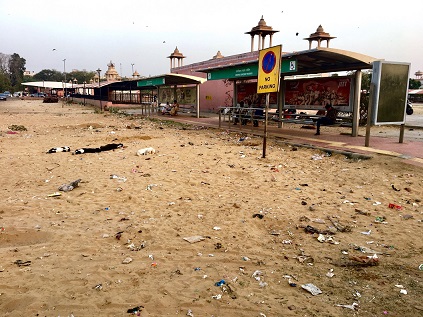
Travelling in India you are inundated with the unfamiliar and the unexplained. Surprising sights quickly become the norm as you adapt to new ways of doing business and getting around. So why is it that I cannot keep from being shocked by the waste left lying in almost any piece of open ground? Particularly in rural Rajasthan, it is impossible to miss the large amounts of waste which litter the side of the roads and streets. Plastic items, food waste, scraps of metal and chai tea cups are some of the common items which are seen on the road. Ideas and attitudes towards public space and waste in India have captured my interest. Why is it that there seems to be such a difference in the social attitude to waste and its disposal between India and Australia?
The twin absences of education and law enforcement certainty play a role. According to a number of studies of rural areas in Karnataka and Chennai, environmental awareness is low among the residents and education opportunities in environmental sustainability are rare. It is also common for the local rural residents to leave waste in public areas knowing there are no penalties or enforcement of waste management policies.
Alongside the lack of awareness and enforcement, there is an interesting cultural twist: dumped waste can be viewed as a religious offering. It appears that rubbish on the sides of roads is often thought of as an offering to the cows that roam freely around the streets, towns and villages. The majority of the population in India is Hindu and consider cows to be holy. The discarded waste is regarded as a food offering for the animals. This belief system turns waste left in public into an act of communal reverence.
In principal, the idea of providing the cows with food scraps might once have worked well as a simple form of recycling. The problem now is the increasing amount of plastic in discarded waste. If eaten, plastic poses considerable risk for the cows, either killing them or causing their milk to become toxic. The rapid increase in population has also meant that there are much larger proportions of this trash, which has meant that there is excess waste not even touched by the cows.
Are our Australian attitudes to waste really that much more evolved? We certainly are wealthy enough to have garbage collected and transported to large dumps. Out of site out of mind, we probably think as little of what happens to our waste once we have thrown it into a bin as does the Indian villager. I see waste disposal as a critical issue for a country such as India. As this waste builds up it can cause environmental degradation and contamination of essential natural resources so essential to human well-being.
Shopping Across India
By Chantal Young
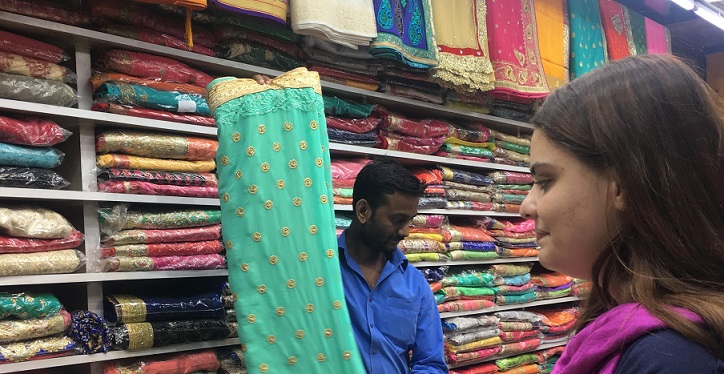
Okay let’s face it – I love shopping. Throughout this field school, if there is a shop to visit I’ll be there. India provides a wealth of unique handicrafts, leather goods and beautiful textiles and I have a collection of mementos sourced from diverse locations such as entrepreneurial artisans in Dharavi slum to women’s collectives of northern India. Having worked in Australian retail throughout the duration of my undergraduate studies, I also have a degree of fascination and affinity with the shopkeepers I have met along the way.
Recently in Ranthambore, an area famous for tiger safaris, I visited a handicraft market adjacent to our hotel. Here I got talking to Ashok, the man who runs the stalls. Chatting over beautiful silks we began comparing work conditions. We both cut fabric for a living, just 10,000km apart, and it turns out that while I earn $20/hour part time, working a maximum of 10hour days, Ashok works 14hour days earning just 7000 rupees a month, or about $140. The shop was lovely, packed with fabrics and gifts, and I managed to spend nearly his month’s salary in an evening. This really drove home the issue of India’s income challenges in a very personal way.
In seminars, lectures and field visits a major theme has been wealth and poverty in India, and the vast economic inequalities. Currently, India is said to be the second most unequal country in the world, with the richest 10% of Indians owning 80% of the wealth. This trend is increasing every year, with around 30% of the population living below the poverty line.
Market liberalisation since 1991 has encouraged traditional skills and trades to engage in entrepreneurship within the capitalist market to increase income, and the results of this were evident in several of the handicraft markets we have visited throughout the trip. Many of these businesses focus on positive social change, and increasing the standards of living for the poor and marginalised. One example is Bunkaar Textiles, a rural woman’s collective weaving and embroidering scarves for sale, or Dharavi leather goods which sells bags, belts, and wallets made by leatherworkers in the Mumbai slum. While these initiatives are a great start to secure income streams for groups of people living below the poverty line, it will take larger initiatives to really transform lives across the nation through income and employment.
In 2005 the government established the National Rural Employment Guarantee, a progressive act which aims to guarantee the ‘right to work,’ and enhance livelihood security in rural areas by providing at least 100 days of wage employment per year. In 2014 the World Bank described the program as a ‘stellar example of rural development’ and it appears to be ‘slowly but surely’ making a positive difference in the lives of the rural poor. Yet the government still lacks a social welfare payments scheme which would see the unemployed or underpaid guaranteed income payments to meet basic needs. Instead, there is a complex array of subsidies and grain rations to households sitting below the poverty line. On our Ranthambore safari we did not manage to see a tiger, so Ashok gave me a tiger postcard at the store. Just like this ‘consolation prize,’ allocation of grain rations comes as a welcome but poor second to monetary welfare payments and the financial freedom that accompanies them.
The issue of how best to deal with income inequality and poverty are not isolated to India, and back in Australia we debate over the relatively low minimum wage of retail, arguing it is not enough considering the high cost of living in Sydney. But visiting India and interacting with the retail industry here has put this in perspective for me, and I am extremely grateful for the employment standards and welfare systems we do have.
As our tour guide in Dharavi said, ‘change is the only constant in India,’ and everything is changing very fast. A new middle class is burgeoning, and I look forward to the day when these inequalities in India can be reduced and Ashok does not need to work 14hour days to make ends meet. In the meantime, shopping in India certainly has been an eye opening experience speaking to many of the income issues facing the nation today.
Transport Worries
By Sam Lehmann
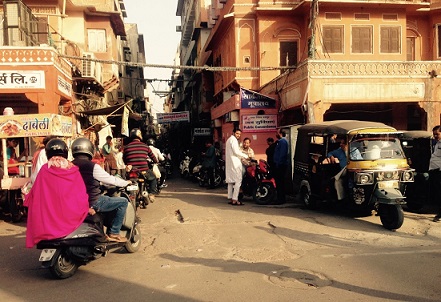
The most common form of vehicular transport in Mumbai is the scooter. The number of two-wheelers resembles a swarm of bees. The noise these vehicles generate is minimal, though horns are perhaps the most common sound you hear in India. In addition to scooters, auto-rickshaws, cars, bicycles, animals, buses and trains are common modes of transport. Which mode of transport a person uses is, to a large extent, determined by their economic capacity.
Scooters are the most affordable of any motorised private vehicle available in Mumbai. Purchasing a scooter will set the buyer back anywhere upward of ₹40,000 (Indian Rupees) or about $800 Australian dollars – a new ‘TVS Scooty Pep Plus’ sells for slightly more than ₹40,000. The TVS is specifically marketed to the needs of the average budget conscious Mumbai resident. It is low powered but fuel efficient. The rider will be able to ride 300 or so kilometres on a single 5 litre tank of fuel. And, with fuel costing roughly ₹80 ($1.50) per litre, ongoing costs are minimal. However, due to the relative affordability of scooters such as the TVS, the number of scooters in Mumbai is becoming problematic.
Between 2006 and 2016 the number of scooters on Mumbai roads grew from 790,000 to 1.6 million. This is a sign of increased wealth. During the same period, the Maharashtra state government built only 2000km of new roads, in a city spanning more than 600 square kilometres. The growing number of scooters on Mumbai’s roads, congestion and pollution are all troubling issues. How will Mumbai, and India more generally, cope with the inevitable growth of two-wheeled motorised transport that comes with economic growth?
In the recent national budget, the Indian finance minister Arun Jaitley outlined the central government’s plan to spend more than ₹50 lakh crore ($90 billion) on transport infrastructure. The allocation of such a massive amount of money will make inroads into the growing transport problem. Of this $90 billion, a large proportion is expected to be spent developing transport infrastructure in and around “areas of economic importance” ( 2018 Budget, page 4). This bodes well for Mumbai so long as the planned funding is rationally spent.
The 21st century will reveal many development challenges for the people of Mumbai. The need for equitable modes of transport is only one of these. It is crucial that viable transport systems are developed to cope with an already massive, but growing, population. Though scooters may well be a feasible and affordable mode of transport today, the presence of an additional 1.6 million scooters in Mumbai would create havoc in an already stressed transport system.

